* * *
It is worth to look around in the attic, as you can find all kinds of delicacies. Can anyone seriously think that an eight-page glossary is a real practical help in the communication between people who do not know the language of each other? How to write down the words so that people not familiar with the language recognize them? What cannot people do out of despair?
We have already presented, by the courtesy of Poemas of Río Wang, a Russian-Estonian military phrasebook. As a continuation, one of our readers has surprised us with an interesting Russian-Hungarian dictionary, or more precisely with a substitute for a dictionary, only in eight pages. The booklet was found in the attic of the grandfather of our reader, in the Western Hungarian village of Süttör (now belonging to the town of Fertőd).
 „What did the tovarish say? The only substitute for a Russian-Hungarian dictionary. To the hitherto published Hungarian-Russian dictionaries now we add a Russian-Hungarian dictionary, so we can understand what our Russian brothers want to tell to us. (This was not offered by any of the hitherto published dictionaries.)”
„What did the tovarish say? The only substitute for a Russian-Hungarian dictionary. To the hitherto published Hungarian-Russian dictionaries now we add a Russian-Hungarian dictionary, so we can understand what our Russian brothers want to tell to us. (This was not offered by any of the hitherto published dictionaries.)”The dictionary was published without indication of year, probably at the immediate end of the Second World War. Its author, Elemér Hajós is unknown, at least on the basis of this publication he cannot be identified with the educational writer publishing between the 30s and 50s.
For the sake of the younger generation we have to say that tovaris [we render the Russian words with the Hungarian orthography as they figure in the dictionary] means ’companion, friend’, but it is also the equivalent of comrade.
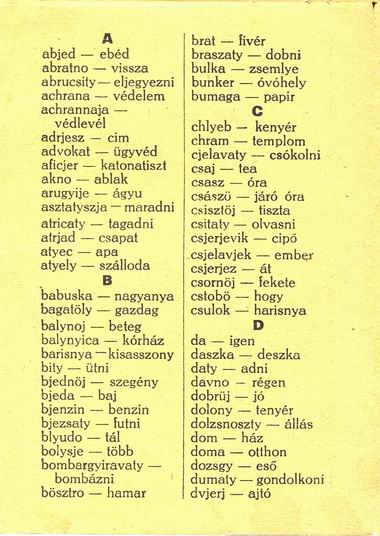
In the Russian part of the dictionary the words are listed according to their pronunciation, in Hungarian alphabetical order. The soft pair of l is indicated with ly, if there is no equivalent soft Hungarian consonant (gy, ny, ty), before a, e and at the end of the word j denotes the softness of the consonant, while before i the designation is omitted. It is interesting that velar i is represented with ö instead of i or ü as it is usual in modern Hungarian transcription. Unstressed o is transcribed as a, while word emphasis is not indicated in any way.
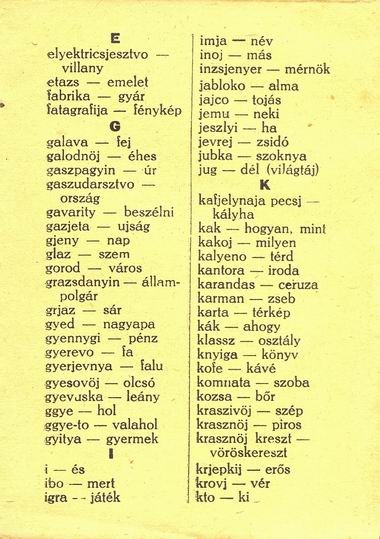
Printing gjeny instead of gyeny was certainly a typo, and to render the vowel in kák with an accent is a rare exception. In contrast to the transcription of unstressed o according to its pronunciation, the transcription of unstressed a and e after a soft consonant follows rather the orthography: jajco, and not jico, jemu, and not jimu (but: oszjiny).

The influence of orthography is also shown by the fact that the glossary does not mark the consonant becoming voiceless at the end of the word: krovj instead of krofj, and lavka instead of lafka.
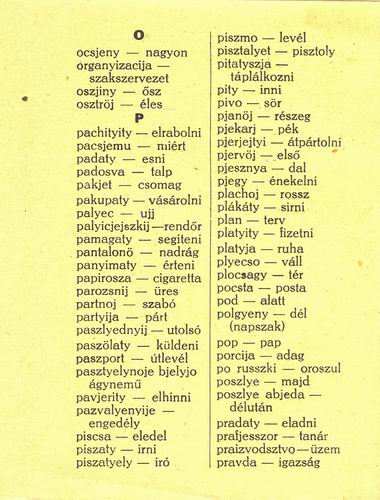
The glossary includes only the most common vocabulary. The words referring to the war are predominant, but this just meets the needs of the period. Military vocabulary is overrepresented even in the later, more extensive Russian-Hungarian dictionaries. All the more strange is the emergence of the words referring to religion. The choice of ethnonyms is also interesting: besides ’Russian’ we also find ’German’, and moreover ’Jewish’ figures with two forms (jevrej, zsid) but there is no ’Hungarian’! It is striking that ’child’ is rendered with the obsolete gyitya and not the more general rebjonok.
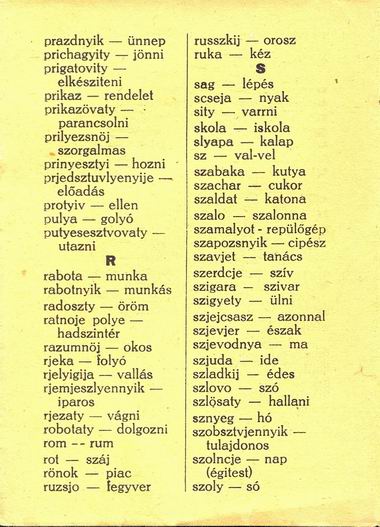
The distribution of various parts of speech seems quite random: we find ’work’ and ’worker’, but not ’working’ (rabotaty). There is a surprising number of conjunctions, although their role is negligible in a broken speech, to which this glossary can be more or less profitable. Verbs figure in their infinitive form, on the basis of which it is virtually impossible to identify a Russian inflected verb.
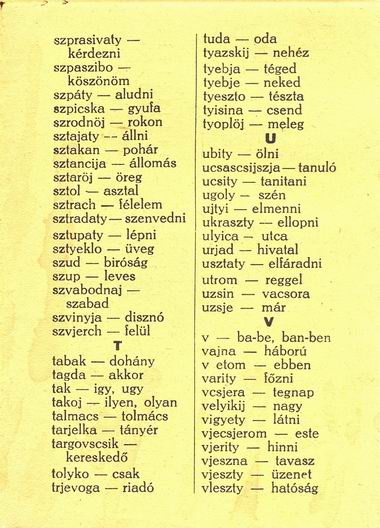
In the glossary there are relatively few errors. Achrannaja, the adjective form of ’protection’ does not mean ’safe-conduct’, only if used in the composite form achrannaja gramata. ’Palm’ is no dolony, but ladony (but it is dolony in Ukrainian, and the fact that the unstressed o is not written as a indicates that here an Ukrainian word slipped in among the Russian ones). Poszlye is not ’later’, but ’after’, and praizvodsztvo is not ’factory’, but ’industry’. It is hard to find out that csasz means ’hour’ and csaszö ’clock’. Plurale tantums are sometimes in singular (csulok), and sometimes in plural (pantalonö). The transcription of Russian words in many cases does not follow the above described rules.
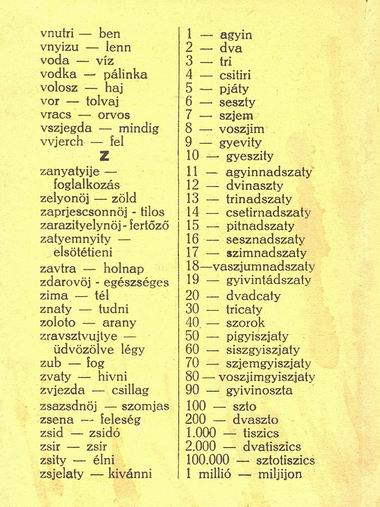
The last page of the glossary, the list of numbers changes the hitherto followed order of languages: here the Russian forms come after the number.
An interesting question is who and how compiled the glossary. The written shape of the Russian words do not strictly follow either the pronunciation or the orthography: they represent a transitional state. It is hard to seriously believe that anyone could have profited of this publication in practice (except, of course, the publisher if they managed to sell it in a significant number), so the more interesting it would be to know why people purchased it. At least this copy which has been preserved in the attic.

























































No hay comentarios:
Publicar un comentario